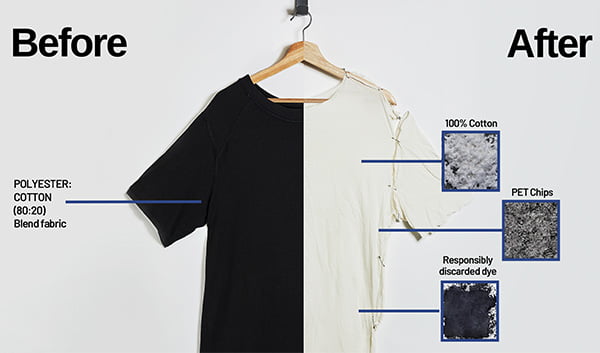This website uses cookies so that we can provide you with the best user experience possible. Cookie information is stored in your browser and performs functions such as recognising you when you return to our website and helping our team to understand which sections of the website you find most interesting and useful.

Two Companies Innovating With Every Fiber
Forbes July 8, 2019
My recent trip to the Circularity 19 conference – the largest circular economy event in North America – left me with a newfound appreciation for the start-ups and established companies on the leading edge of the move toward a more sustainable economic system.
In my last article, I wrote about the work being done to create more sustainable plastics and to recycle them more efficiently. In this article, I highlight two firms that are making great progress in recycling used paper and cloth fiber by breaking used materials down into component parts and creating building blocks that can be reused in new products.
If you are reading this article while sipping from a Starbucks take-out cup, you know that after finishing your latte, you need to throw your used cup in the trash rather than the recycle bin. None of us think about throwing our cup into the trash, but in aggregate, it becomes a big deal ecologically – in the U.S. alone, an estimated 60 billion single-use containers end up getting sent to landfills every year.

One company I met, Sustana Fiber, is working to change the use-and-discard paradigm and develop a circular solution by discovering a way to economically recycle plastic-coated single-use cups.
Sustana’s process mechanically separates the plastic coating from the paper, cleans and treats the pulp, and forms it into sheets that can be combined with virgin fiber to create food containers that are FDA-compliant for direct contact with food under all use conditions. As a way of demonstrating that single-use cups can be recycled, in 2018, Sustana worked on a successful pilot program to recycle 25 million Starbucks cups and turn them back into perfect, FDA-compliant disposable coffee cups.
Sustana sent me a sample cup that contains 32% recycled fiber – three times the amount of recycled feedstock in a typical Starbucks cup. The cup is bright white, sturdy, and, to me, completely indistinguishable from a cup made from virgin materials.
Sustana’s sister company Rolland – which uses recycled pulp to create paper – is also on the forefront of sustainability. For example, 93% of its energy at its St. Jerome Quebec plant are provided by biofuels (see this article to learn about Renewable Natural Gas) and, because its input is recycled fibers, it uses much less water and many fewer harsh chemicals in its manufacturing process.
Also, two of its plants recycle production water 17 times, treats it, and sends it out of the plants cleaner than when it came in. This is an amazing feat, considering that a typical sheet of printer paper made from virgin pulp needs more than three gallons of water in its creation and that pulp and paper plants have long been known for pollution of rivers and lakes.
The other fiber recycling company that caught my eye – Tyton BioSciences – participated in the Accelerate start-up contest at the Circularity 19 conference, pitching the idea of breaking used clothing down into components and fibers which can be used again.
As residents of developed countries, we only see the glamour and sexiness of fashion, but the ecological toll that textile manufacturing takes on developing countries is extremely high. Textile manufacturing requires enormous amounts of water, create chemical waste that pollutes rivers and water tables, and, according to the Ellen MacArthur Foundation, has a larger carbon footprint than all international air flights and maritime shipping combined.
What’s worse is that in recent times, the trend toward “Fast Fashion” has meant that in vogue styles and colors change very quickly, leading to much shorter functional lives for clothing. According to a report by Accenture and the NGO Fashion For Good,
Since 2002, global clothing production has more than doubled, the average consumer buys 60% more and each garment is kept for half as long…just 1% of clothing is recycled back into clothing, 73% goes to landfill.
One of the big problems preventing clothing recycling is that many common articles made with a combination of natural and synthetic fibers, and separating them has been as hard as removing white from rice.
This is where Tyton’s technology comes in. Using a special process whose primary inputs are water, heat, and pressure, Tyton is able to separate synthetic from natural fibers, the former of which can be made into virgin-equivalent recycled polyester pellets; the latter of which can be woven together, singly or with virgin cotton feedstock, to create usable all-cotton cloth.
Tyton’s recycled fiber can also serve as an input to what is known in the business as viscose or modal – Rayon to the rest of us – which are usually made from cellulose gathered from plants like sugar cane and trees like beech.
The technical achievement represented by Tyton’s ability to separate synthetic from natural fibers and recycle them at a building block level is impressive in itself. From an investor’s perspective, though, the economics of Tyton’s technology is beyond compelling.
Tyton estimates that around 10.5 million tons of clothing enters landfill every year. Assuming that clothing is all a 50/50 cotton/poly blend, the company calculates that it can generate around $650 / ton of waste taken in. This works out to a total revenue opportunity of $6.8 billion per year at today’s prices.
Who would Tyton’s clients be? Firms like Adidas, H&M, and The Gap – representing an aggregate annual revenue of over $62 billion – have all committed to aggressive goals for sourcing recycled or sustainably sourced materials over the next few years. Tyton’s recycled clothing fibers go a long way to helping these apparel giants meet their goals.
The businesspeople at Sustana and Tyton are figuring out how to extract the most elemental building block of a product so that building block can be reused. In this way, each company is transforming linear economic systems to circular ones – recycling and reusing rather than mining and manufacturing.
They know, as I do, that we are on the cusp of an enormous paradigm shift that will change the rules by which our economy operates. Intelligent investors looking to generate and maintain intergenerational wealth take note.


